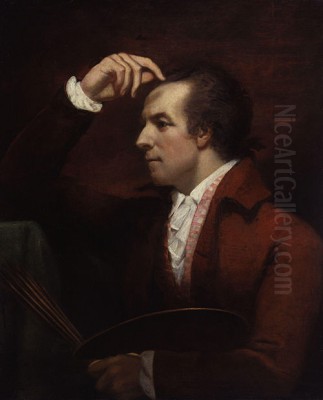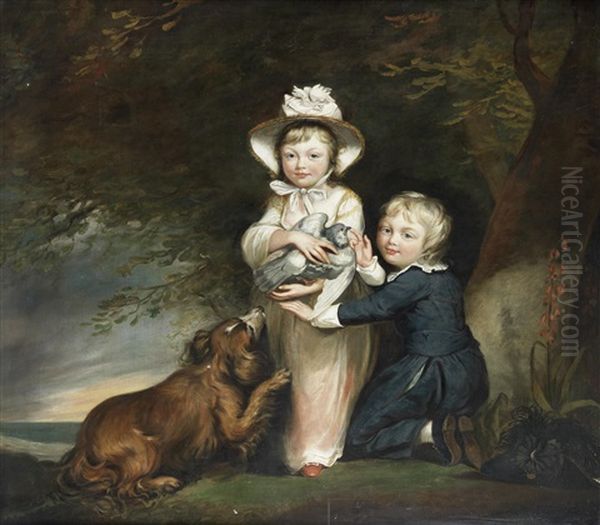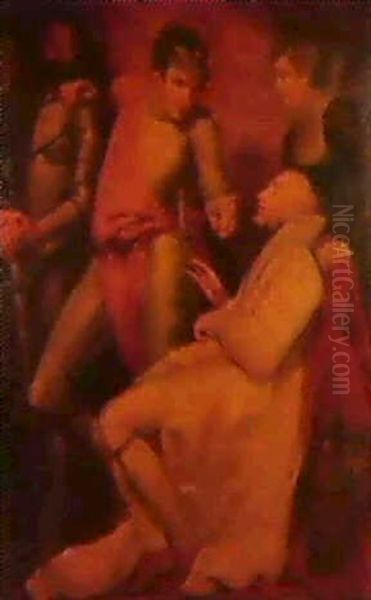
James Northcote stands as a significant figure in the landscape of British art during the late Georgian and Regency periods. Born in Plymouth on October 22, 1746, and living a long life until his death in London on July 13, 1831, Northcote navigated the burgeoning London art world with tenacity and skill. Primarily recognized as a painter of portraits and historical subjects, he also carved out a distinct identity as an author and commentator, leaving behind a body of work that reflects both the artistic ambitions and the intellectual currents of his time. His association with the towering figure of Sir Joshua Reynolds profoundly shaped his early career, but Northcote developed a unique voice, marked by sharp observation, narrative flair, and occasional excursions into unexpected genres.
Early Life and Artistic Awakening in Plymouth
James Northcote's origins were modest. Born in the bustling port town of Plymouth, Devon, he was the son of Samuel Northcote, a watchmaker and clockmaker. Following familial expectation and the common practice of the time, James was initially apprenticed to his father's trade. While he dutifully learned the intricate mechanics of timepieces, his true passion lay elsewhere. From a young age, Northcote harboured a strong desire to draw and paint, pursuing this interest diligently in his spare moments.
His father, though perhaps initially hoping his son would follow in his footsteps, did not entirely discourage this artistic inclination. Sources suggest Samuel Northcote even provided some rudimentary guidance in the use of paints and brushes. However, significant encouragement came from outside the family. The Mudge family, known for their intellectual and scientific pursuits in Plymouth (particularly Dr. John Mudge, a physician and friend of Sir Joshua Reynolds), recognized the young man's talent and potential.
It was through the Mudge family's connections, likely Dr. Mudge himself, that a pivotal introduction was arranged. In 1762, the young, aspiring painter was introduced to Sir Joshua Reynolds, already the most celebrated portrait painter in England and a fellow Devonian. This meeting marked a turning point. While Northcote continued his watchmaking apprenticeship for several more years, the encounter solidified his artistic ambitions.
Apprenticeship under Sir Joshua Reynolds

The desire to pursue art professionally eventually won out over the security of the family trade. In 1769, Northcote formally abandoned watchmaking. Two years later, in 1771, he took the decisive step of moving to London and entering Sir Joshua Reynolds's studio as a pupil and assistant. This was a coveted position, placing him at the very centre of the British art world. Reynolds's studio in Leicester Fields (now Leicester Square) was not just a workshop but a hub of artistic production and intellectual exchange.
For five years, Northcote lived and worked under Reynolds's roof. His duties would have involved the typical tasks of a studio assistant: grinding pigments, preparing canvases, painting drapery and backgrounds in his master's portraits, and making copies of Reynolds's works. This was invaluable training, providing firsthand exposure to Reynolds's techniques, his approach to composition and colour, and his methods for capturing a sitter's likeness and character. Northcote absorbed these lessons deeply, and the influence of Reynolds would remain palpable throughout his career.
Beyond technical instruction, Northcote benefited from the environment Reynolds cultivated. He would have encountered the leading artists, writers, actors, and patrons of the day who frequented Reynolds's studio. Reynolds himself seems to have held his diligent pupil in high regard, recognizing his talent and determination. While some anecdotal accounts of Reynolds's specific praise might be embellished, the duration of Northcote's stay and his subsequent career attest to the value of this formative period.
Establishing an Independent Career
After leaving Reynolds's studio in 1776, Northcote initially sought to broaden his artistic horizons. Like many ambitious British artists of his generation, he embarked on a journey to Italy, the repository of classical antiquity and Renaissance mastery. He spent approximately three years studying the works of the Old Masters, particularly those in Rome, absorbing lessons from Michelangelo, Raphael, and, significantly, Titian, whose biography he would later write. This period was crucial for developing his understanding of grand composition and historical narrative.
Upon his return to England around 1780, Northcote established his own studio in London, determined to make his mark as an independent artist. He sought election to the prestigious Royal Academy of Arts, the institution co-founded by his former master Reynolds, which governed the exhibition and teaching of art in Britain. Northcote began exhibiting regularly at the Academy's annual exhibitions, showcasing his skills in both portraiture and the increasingly ambitious field of history painting. He was elected an Associate of the Royal Academy (ARA) in 1786 and achieved full Academician status (RA) the following year, in 1787, cementing his position within the artistic establishment.
Success in Portraiture

Following in the footsteps of Reynolds, portraiture formed the bedrock of Northcote's professional practice. It was the most reliable source of income for artists in Georgian Britain, fueled by the demand from the aristocracy, the gentry, and the rising professional classes to have their likenesses recorded. Northcote proved adept at capturing not only the physical appearance of his sitters but also a sense of their personality and social standing.
His portrait style, while clearly indebted to Reynolds in its compositional structures and often rich colouring, developed its own characteristics. Northcote's portraits can sometimes exhibit a sharper, more linear quality compared to Reynolds's softer, more painterly approach. He often imbued his sitters with a direct, penetrating gaze, suggesting a keen psychological observation. He painted numerous prominent figures of the day, although perhaps fewer of the highest echelons of society than Reynolds or his younger, flashier rival, Sir Thomas Lawrence.
His work included sensitive portrayals of fellow artists, intellectuals, and members of the professional classes. While specific famous individual portraits are less frequently cited than his history paintings, his consistent output in this genre sustained his career and reputation for decades. The series The Modest Girl and the Wanton (completed 1796), though narrative in intent, demonstrates his skill in rendering character and expression within a portrait-like format.
Ambitions in History Painting
While portraiture paid the bills, Northcote, like many of his contemporaries, harboured ambitions in the more highly esteemed genre of history painting. Drawing inspiration from classical mythology, the Bible, literature (especially Shakespeare), and British history, these large-scale works aimed for moral edification and national prestige. The late 18th century saw a concerted effort to elevate British art through historical subjects, most famously embodied by Alderman John Boydell's Shakespeare Gallery project, for which Northcote contributed several works.
Northcote's Italian studies had prepared him for the demands of complex multi-figure compositions and dramatic narrative. One of his earliest significant history paintings, exhibited upon his return from Italy, was The Young Princes Murdered in the Tower (1786). This depiction of the presumed fate of Edward V and his brother Richard, Duke of York, tapped into a popular historical subject, blending pathos with gothic intrigue. The painting showcased his ability to handle dramatic lighting and convey emotional intensity.
Another major work in this vein was The Death of Wat Tyler (1787). This painting depicted the dramatic confrontation during the Peasants' Revolt of 1381, where the rebel leader Wat Tyler was struck down in the presence of the young King Richard II. Commissioned for a specific location within the City of London's administration buildings, this work engaged directly with a moment of national historical significance, demonstrating Northcote's ambition to contribute to a grand narrative of British history. These works, along with his contributions to the Shakespeare Gallery, positioned Northcote as a leading history painter of his generation, alongside figures like Benjamin West (Reynolds's successor as President of the Royal Academy) and John Singleton Copley.
Rivalries and the London Art World
The London art world of the late 18th and early 19th centuries was a competitive arena. Artists vied for patronage, critical acclaim, and prestige within the Royal Academy. Northcote, known for his somewhat sharp and parsimonious character, navigated this world with a keen sense of rivalry. His most notable competitors included the Cornish painter John Opie and the Swiss-born artist Henry Fuseli.
John Opie, like Northcote, came from a provincial background and possessed a raw, vigorous talent, particularly in portraiture. Their careers ran parallel in many ways, and a distinct sense of competition existed between them as they sought commissions and recognition. Henry Fuseli, on the other hand, offered a stark contrast with his highly imaginative, often dark and psychologically intense depictions of literary and mythological subjects. While different in style, Fuseli also competed in the realm of ambitious subject painting. Northcote's interactions with these and other artists, such as the fashionable portraitist George Romney or the landscape innovator Joseph Wright of Derby, were part of the dynamic fabric of the era's artistic life.
Northcote's long career spanned a period of immense artistic activity, witnessing the dominance of Reynolds, the elegance of Thomas Gainsborough, the rise of Sir Thomas Lawrence, the visionary work of William Blake, and the burgeoning school of British landscape painting led by J.M.W. Turner and John Constable. While primarily a figure painter, Northcote operated within this rich and varied artistic milieu.
Literary Pursuits: Biographer and Fabulist
Beyond his prolific output as a painter, James Northcote cultivated a parallel career as a writer. This dual identity was relatively unusual for artists of his time and adds a fascinating dimension to his legacy. His most significant literary undertaking was undoubtedly his Memoirs of Sir Joshua Reynolds, first published in 1813 and later expanded. Drawing on his intimate knowledge as a former pupil and long-time acquaintance, the biography offered valuable insights into Reynolds's life, working methods, and opinions. While sometimes criticized for its anecdotal style or perceived biases, it remains a crucial primary source for understanding the most influential British artist of the 18th century.
Northcote's literary interests extended further. He later published a Life of Titian (1830), reflecting his admiration for the Venetian master he had studied closely in Italy. This work demonstrated his engagement with art history and his desire to contribute to the scholarly discourse surrounding the Old Masters.
Perhaps his most unique literary and artistic fusion was One Hundred Fables, Original and Selected (published in two series, the first in 1828, the second posthumously in 1833). These were not simply illustrated texts. Northcote designed the intricate wood engravings himself, often incorporating elements in a collage-like manner, using fragments of earlier prints. Each fable was accompanied by Northcote's own reflections or interpretations. The work was highly personal, blending moral instruction with artistic ingenuity, and proved very popular. The reference in the provided snippets to 175 fables might encompass both series or reflect variations in editions. This project showcased his inventiveness and his enduring interest in narrative and moral commentary.
The Hazlitt Connection
Northcote's later years were notably illuminated by his friendship and extensive conversations with the brilliant essayist and critic William Hazlitt. Hazlitt, fascinated by Northcote's long memory, sharp wit, and candid opinions, visited him regularly and meticulously recorded their dialogues. These were published serially and later collected as Conversations of James Northcote, Esq., R.A. (1830).
These conversations provide an invaluable, unvarnished glimpse into Northcote's personality, his views on art and artists (often acerbic), his recollections of Reynolds and his circle, and his broader reflections on life and human nature. While Northcote sometimes felt Hazlitt had been indiscreet in publishing his frank remarks, the Conversations remain a classic of biographical literature. It's important to clarify that famous essay titles mentioned in the initial snippets, such as "On the Feeling of Immortality in Youth" and "On the Ignorance of the Learned," are indeed Hazlitt's own celebrated works, though the themes were likely subjects of discussion between the two men. Hazlitt also wrote appreciatively about Northcote's art, including a review of his late painting Titania.
Late Career and Animal Painting
Northcote remained remarkably productive into old age. While he continued to paint portraits and occasional historical subjects, his later career saw a notable increase in paintings featuring animals. These works, often depicting exotic creatures like leopards and lions, or domestic animals in narrative settings (e.g., The Dog and the Crane), found considerable favour with the public and proved commercially successful.
This interest in animal subjects was not merely opportunistic; it allowed Northcote to explore different textures, forms, and dramatic scenarios. While perhaps not possessing the profound anatomical understanding of a specialist like George Stubbs, Northcote brought his narrative skills to these subjects, often imbuing them with allegorical or moralistic undertones, linking them thematically to his Fables. These animal paintings added another layer to his diverse output, demonstrating his adaptability and continued engagement with popular taste. One notable late work mentioned is Head of a Negro in the Character of Othello, exhibited in Manchester in 1827, indicating an occasional engagement with subjects drawn from Shakespeare featuring non-European figures, a relatively rare theme in his oeuvre.
Legacy and Conclusion
James Northcote died in London in 1831 at the advanced age of 84. He left behind a substantial fortune, amassed through decades of diligent work and careful living, and a significant artistic and literary legacy. As a painter, he was a key figure in the generation that followed Reynolds, contributing significantly to the fields of portraiture and history painting in Britain. His works like The Young Princes Murdered in the Tower and The Death of Wat Tyler represent important examples of British historical art.
His role as Reynolds's biographer secured his place in art historical literature, providing indispensable material for subsequent scholarship. His One Hundred Fables stands as a unique creation, blending visual artistry with literary tradition in an inventive format. Furthermore, his recorded Conversations with Hazlitt offer a vivid portrait of the artist and his times, preserving his distinctive voice and sharp intellect for posterity.
Though perhaps overshadowed in popular memory by his master Reynolds, or by more flamboyant contemporaries like Fuseli or Lawrence, James Northcote remains a figure of considerable importance. He was a skilled and versatile painter, a dedicated chronicler of his mentor, an innovative creator of fables, and a shrewd observer of the human condition. His long life bridged the confident classicism of the Georgian era and the burgeoning Romanticism of the early 19th century, and his work reflects the complexities and ambitions of that transformative period in British art and culture. He remains a testament to the possibilities of a sustained career built on talent, diligence, and a keen engagement with the artistic and intellectual life of his time.